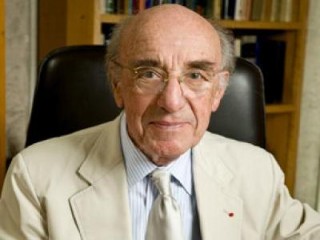
Roger Guillemin biography
Date of birth : 1924-01-11
Date of death : -
Birthplace : Dijon, Bourgogne, France
Nationality : French
Category : Science and Technology
Last modified : 2011-12-20
Credited as : scientist, research into brain hormones, Nobel laureate
1 votes so far
Completing his undergraduate work at the University of Burgundy, Guillemin received his M.D. degree from the Medical Faculty at Lyon in 1949, and went to Montreal, Quebec, Canada, to work with Hans Selye at the Institute of Experimental Medicine and Surgery at the Université de Montréal where he received a Ph.D. in 1953. The same year he moved to the United States to join the faculty at Baylor College of Medicine at Houston. In 1965, he became a naturalized citizen of the United States. In 1970 he helped in creating the Salk Institute in La Jolla, California where he worked until retirement in 1989.
Roger Guillemin shared the Nobel Prize for Medicine or Physiology in 1977 with Andrew V. Schally, for their separate and often hotly competed research into brain hormones, and with Rosalyn Sussman Yalow, for her development of radioimmunoassays of peptid hormones. Guillemin proved the hypothesis that the pituitary gland is regulated by hypothalamus releases, and discovered endorphins (proteins involved in the perception of pain), somatocrinin (the growth-hormone releasing factor hormone, also called GHR or GHRF, which is used to treat growth deficiencies in children); and somatostatin (the growth-hormone-inhibiting hormone, also called GHIH, which is used to inhibit internal bleeding during surgery).
He also studied activins and inhibins (peptides that help regulates the menstrual cycle) and fibroblast growth factors receptors (FGFs, now used in treatment for eye diseases and diabetic blindness).
During World War II, Guillemin's French homeland was occupied by German forces, and he interrupted his studies to become active in the French resistance, serving in an underground network that helped refugees escape to Switzerland over the Jura Mountains. In the early 1950s, he nearly died of tubercular meningitis, but recovered and married his nurse, Lucienne Jeanne Billard.
They became American citizens in 1963, and she became a professional harpsichord player. Following his retirement in 1989, Guillemin became an accomplished creator of abstract impressionist art, using his Macintosh computer to create his images that are then transferred to either canvas or paper, via lithography or inkjet processes. His works have been exhibited in major American and European galleries.
Author of books:
-Pharmacological Control of Release of Hormones including Anti-Diabetic Drugs (1962)
-The Hormones of the Hypothalamus (1972, with Roger Burgus)
-The Brain as an Endocrine Organ (1978)
-Neural Modulation of Immunity (1984)
-Hypothalamic Control of Pituitary Functions:The Growth Hormone Releasing Factor (1986)
















